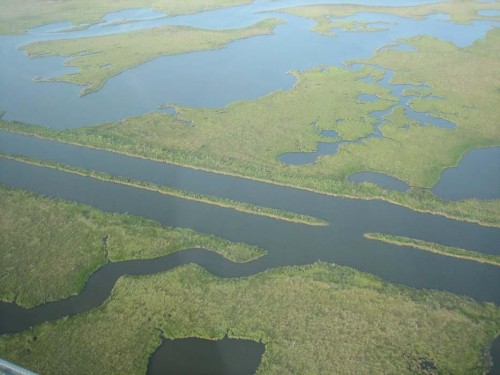Esma Orgeron
July 2, 2007
NSU business college dean elected to state CPA board
July 4, 2007Sen. Reggie P. Dupre, D-Houma, said the state’s looking good as far as coastal protection goes and a lot has been accomplished since the 2005 hurricane season.
“I think we’re looking very good for coastal protection in general. There’s a lot of activity that’s occurred at the state level in the last 20 months, beginning from November 2005 session until today,” he said.
Dupre said the legislature started setting up the framework for the current day’s coastal protection projects after the 2005 storms.
And they began by consolidating and integrating coastal restoration with hurricane protection with the creation of the Coastal Protection and Restoration Authority and the dedication of all future OCS revenues.
Dupre said the majority of Louisiana citizens, by an 82 percent margin, support the dedication of the monies to coastal protection.
Of course, dedicating this revenue and using it as quickly as possible were not easy tasks.
The legislature had to approve the formation of a state-run public corporation, the Louisiana Coastal Protection and Restoration Financing Corp., to securitize the revenues.
The corporation is similar to the tobacco corporation that was set up to securitize the revenue generated from the state’s tobacco settlement.
“We have to remember, when Congress passed the OCS bill in December 2006, it provided and average of about $20 million a year for the first 10 years to the state of Louisiana and then the figure jumps to around $600 million a year beginning in the year 2017 and thereafter,” Dupre said.
Dupre said the $20 million a year isn’t much, especially when compared to the $25 million existing in recurring revenue from the state each year.
“So, in order to get some of these projects jump-started, where we’re ready to go on barrier islands or some of these component parts of Morganza, or other parts of Louisiana, because this is not just a Terrebonne and Lafourche issue,” said Dupre. “It’s a statewide issue, especially the coastal issue throughout coastal Louisiana. We’re going to be able to have the option in the next year or two of bonding out future OCS revenues.”
So by forming the corporation, the bonding won’t count toward the state’s general debt limit and will not be subject to the full faith and credit of the state. The bill that approves the formation of the corporation is headed to Gov. Kathleen Blanco’s desk and she is expected to sign it.
Dupre was the bill’s sponsor.
“After setting up the framework this year it seems we’re going to have some very, very significant funds for coastal protection, more than we’ve ever had before,” he said.
Dupre said the legislature has gone to the next level in trying to fund major projects like the Morganza to the Gulf project.
He said of the $1.9 billion supplemental appropriations bill, $200 million will go toward coastal protection, of which, the Mogranza to the Gulf project will get $10 million and the Golden Meadow Lock project will grab $18 million.
And in state House Bill 2, the Morganza to the Gulf got $54 million.
Also, the LA 1 project also got $63 million.
The Morganza to the Gulf project is moving along, too.
Dupre said the J-1 section of Morganza is nearly complete thanks to $16 million funded with a combination of a local quarter-cent sales tax and some state dollars.
Dupre also said the J-2 and H-3 reaches are being engineered right now and he thinks the available funding will be enough to go to bed with these reaches.
The Morganza to the Gulf project differs from past projects, because non-federal sponsors – the state and local governments – are working 100 percent on the most vulnerable portion of the project, the area between Bayou Pointe-Au-Chene and Bayou Picayune.
Dupre said rather than having the Corps participate at 65 percent, the non-federal sponsors are responsible for this section. This was done to get that part of the project built faster without the Corps.
“A lot of us believe the non-federal sponsors can build that section a lot quicker and faster than waiting on the Corps normal, very slow construction schedule and very expensive, inflationary figures that go into projects,” said Dupre.
The session did see at least one defeat, a temporary one at least.
Dupre said Rep. Gordon Dove, R-Houma, had been working hard on putting together a barrier island stabilization fund.
State House Bill 1 would have allowed $64 million to go toward the barrier island fund, but the money was contingent on whether or not the remaining 40 percent trust of the tobacco settlement would be sold.
And it didn’t. Dove said the loss of funding was unfortunate, but he understood the decision from a business perspective. It just wasn’t the best time to sell the rest of the settlement.
This $64 million figure came from the $320 million that would go to coastal restoration from the settlement, of which the barrier island fund would get 20 percent.
The other big piece of the hurricane protection puzzle is the Houma Navigational Canal.
Dupre said the state also got $43 million from the Coastal Impact Assistance fund to start the lock on the Houma Navigation Canal.
“A lot of these projects take a long time to design. A levee only might take a year, 1 1/2 years to do all your borings and your design work, but a floodgate takes considerably longer. And I guess the floodgate and, or lock in the Houma Navigational Canal takes even longer,” he said.
Dupre said the Houma Navigational Canal Lock Complex includes a 200-foot wide floodgate and a 110-foot by 800-foot lock. He would like to see these projects split up to provide as much protection as possible, as soon as possible.
“I’m a proponent of splitting the projects and building the floodgate now,” said Dupre.
He said the lock can be completed later when the OCS revenues start coming.
“But, I think with the $43 million, plus the other monies we’ll be bale to acquire over the next couple of years, we can certainly build that floodgate to protect most of the populated areas of Terrebonne, because that’s our biggest vulnerability here is the Houma Navigational Canal,” said Dupre. “That’s got to be the number one priority for the majority of the population.”
There also have been a few small legislative funding victories at the federal level worth mentioning. Funding for a few projects have been added to the U.S. Senate Energy and Water Appropriations Bill, which recently passed through the U.S. Senate Appropriations Committee.
The Morganza project may now gain $4 million from the passage of the bill to conduct a 5,500-square-mile study, which would include the HNC and the Houma locks.
The study would be designed to address the problems of high levels of marsh deterioration, saltwater intrusion and flooding in the area.
Also if the bill passes, $2 million in funding will be dedicated for dredging the 384-mile Gulf Intracoastal Waterway.
The waterway is supposed to be at least 12 feet deep and 125 feet in width. Parts of it are not.
And the Louisiana Coastal Area Ecosystem Restoration project stands to gain $14 million in federal funding in the same appropriations bill.
The funding will help the project identify and explore long-range, large scale ecosystem restoration strategies to restore and protect coastal Louisiana.
The study includes 20 parishes and its features include barrier island restoration, marsh creation and river diversion.













